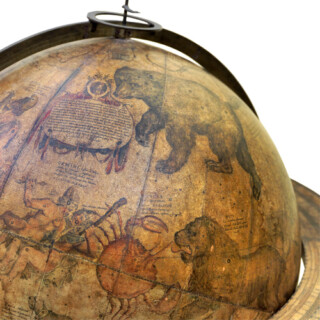Kussenkast.
[The Netherlands,
c1670].
A large solid oak cabinet, surmounted by a straight entablature, with characteristic frieze, architrave, and projecting cornice set with three lion's masks; the front with two doors decorated with fine rosewood, ebony, and ebonised marquetry, in a strict architectural format of scrolling foliage, flanked by half round pilasters with carved capitals - enclosing the cabinet with a single oak shelf - and each side, with rectangular panels set with moulded corniches, the lower front is set with two drawers each with original wooden handles; all seated on three original ball feet, restored and refinished.
2090 by 2400mm (82.25 by 94.5 inches).
23919
notes:
A magnificent and elegant kussenkast, typical of the Dutch late seventeenth century style. The title-page of the French translation of Lucas Waghenaer's celebrated 'Spieghel der Zeevaerdt' - 'Thresorerie ou cabinet de la routte marinesque' (1600), illustrates just such a cabinet for the display and safe-keeping of the most important atlases, and travel accounts: the perfect metaphor for Waghenaer's own maritime atlas, which was a pioneering synthesis of information gathere...
bibliography:
Schilder, 'Monumenta Cartographica Neerlandica', Volume VII.
provenance:







![[Anonymous] Kussenkast.](https://i0.wp.com/crouchrarebooks.com/wp-content/uploads/2025/03/23919_1H.jpg?fit=4000%2C3303&ssl=1)
![[Anonymous] Kussenkast.](https://i0.wp.com/crouchrarebooks.com/wp-content/uploads/2025/03/23919_2H.jpg?fit=2980%2C3728&ssl=1)
